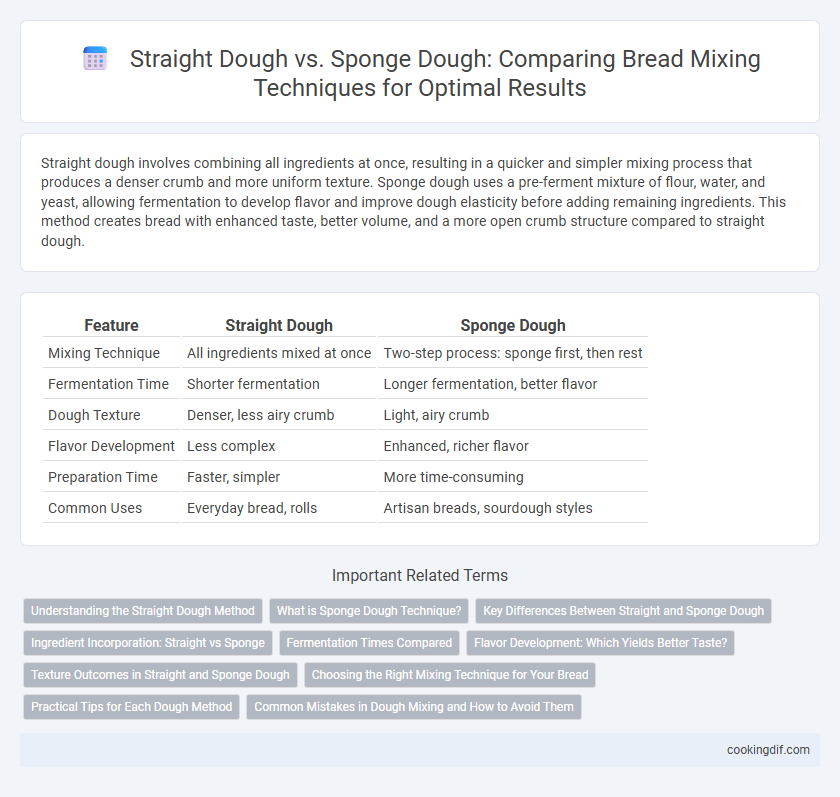Straight dough involves combining all ingredients at once, resulting in a quicker and simpler mixing process that produces a denser crumb and more uniform texture. Sponge dough uses a pre-ferment mixture of flour, water, and yeast, allowing fermentation to develop flavor and improve dough elasticity before adding remaining ingredients. This method creates bread with enhanced taste, better volume, and a more open crumb structure compared to straight dough.
Table of Comparison
| Feature | Straight Dough | Sponge Dough |
|---|---|---|
| Mixing Technique | All ingredients mixed at once | Two-step process: sponge first, then rest |
| Fermentation Time | Shorter fermentation | Longer fermentation, better flavor |
| Dough Texture | Denser, less airy crumb | Light, airy crumb |
| Flavor Development | Less complex | Enhanced, richer flavor |
| Preparation Time | Faster, simpler | More time-consuming |
| Common Uses | Everyday bread, rolls | Artisan breads, sourdough styles |
Understanding the Straight Dough Method
The Straight Dough method involves mixing all ingredients--flour, water, yeast, salt, and other additions--in a single step, streamlining the bread-making process and reducing preparation time. This technique promotes consistent yeast activity and fermentation, resulting in a uniform crumb structure and predictable rise in bread such as sandwich loaves and rustic breads. Understanding the Straight Dough method enhances efficiency in bakeries by simplifying workflow while maintaining quality and flavor in the final baked product.
What is Sponge Dough Technique?
The sponge dough technique involves fermenting a portion of the dough's ingredients, typically water, flour, and yeast, into a bubbly, aerated sponge before adding the remaining ingredients. This pre-fermentation step enhances gluten development and improves flavor complexity by allowing yeast activity and enzymatic processes to intensify. Bakers use sponge dough to achieve a lighter crumb structure and richer taste compared to the straight dough method, where all ingredients are mixed at once without pre-fermentation.
Key Differences Between Straight and Sponge Dough
Straight dough method mixes all ingredients simultaneously, resulting in a shorter fermentation time and a simpler process ideal for quick bread production. Sponge dough technique divides fermentation into two stages, starting with a sponge or pre-ferment that enhances flavor development, texture, and yeast activity. Key differences include fermentation duration, complexity, and impact on bread crumb structure and taste profile.
Ingredient Incorporation: Straight vs Sponge
Straight dough method incorporates all ingredients simultaneously, ensuring a rapid and straightforward mixing process that promotes uniform hydration and gluten development. In contrast, sponge dough technique separates flour, water, and yeast into a pre-fermented sponge, enhancing yeast activity and flavor complexity before combining with remaining ingredients. This staged ingredient incorporation in sponge dough improves dough elasticity and overall bread texture compared to the straight dough method.
Fermentation Times Compared
Straight dough mixing involves combining all ingredients at once, leading to shorter fermentation times typically ranging from 1 to 2 hours, resulting in a quicker bread-making process. Sponge dough requires an initial fermentation of the sponge mixture, usually lasting between 4 to 12 hours, allowing for enhanced yeast activity and flavor development before the final dough is mixed. The extended fermentation in sponge dough contributes to improved gluten structure and a more complex taste profile compared to the faster straight dough method.
Flavor Development: Which Yields Better Taste?
Straight dough mixing involves combining all ingredients at once, resulting in a quicker fermentation process but a less complex flavor profile. Sponge dough, which uses a pre-ferment mixture, enhances yeast activity and develops deeper, more nuanced flavors due to extended fermentation time. Bakeries seeking richer taste and improved texture often prefer sponge dough for its superior flavor development over straight dough.
Texture Outcomes in Straight and Sponge Dough
Straight dough yields bread with a denser crumb and a firmer crust due to the single mixing and fermentation process, which limits gluten development. Sponge dough, involving preliminary fermentation of a portion of the dough, produces a lighter, airier texture with larger, irregular holes and a softer crust. This method enhances enzymatic activity and yeast fermentation, resulting in improved flavor complexity and moisture retention in the final bread.
Choosing the Right Mixing Technique for Your Bread
Straight dough method involves combining all ingredients at once, resulting in a faster mixing process and consistent fermentation, ideal for simpler bread recipes. Sponge dough technique begins with a pre-ferment of flour, water, and yeast, enhancing flavor development and crumb texture through longer fermentation. Selecting the appropriate technique depends on desired bread characteristics, fermentation time, and complexity of flavor, with sponge dough offering depth and straight dough providing efficiency.
Practical Tips for Each Dough Method
Straight dough mixing involves combining all ingredients at once for a faster process, ideal for beginners or small batches. Sponge dough requires fermenting a pre-ferment made of flour, water, and yeast, enhancing flavor and texture through extended fermentation. Use warm water to activate yeast quickly in straight dough, while maintaining controlled temperatures around 75degF during sponge fermentation ensures optimal yeast activity and gluten development.
Common Mistakes in Dough Mixing and How to Avoid Them
Common mistakes in mixing straight dough include overmixing, which can result in a tough texture, and uneven ingredient distribution, impacting fermentation and rise. Sponge dough errors often involve insufficient fermentation time for the sponge, leading to poor gluten development and dense bread. Avoid these by carefully timing fermentation stages and mixing just until ingredients are fully combined, ensuring optimal gluten structure and even yeast activity.
Straight Dough vs Sponge Dough for mixing techniques Infographic

 cookingdif.com
cookingdif.com